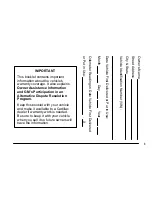
DRIVING TIPS
251
TIPS FOR DRIVING IN VARIOUS
CONDITIONS
D
Always slow down in gusty crosswinds. This will allow you
much better control.
D
Drive slowly onto curbs and, if possible, at a right angle.
Avoid driving onto high, sharp
−
edged objects and other
road hazards. Failure to do so can lead to severe tire
damage resulting in tire bursts.
Drive slowly when passing over bumps or travelling on a
bumpy road. Otherwise, the impact could cause severe
damage to the tires and/or wheels.
D
When parking on a hill, turn the front wheels until they touch
the curb so that the vehicle will not roll. Apply the parking
brake, and place the transmission in “P”. If necessary, block
the wheels.
D
Washing your vehicle or driving through deep water may get
the brakes wet. To see whether they are wet, check that
there is no traffic near you and then press the pedal lightly.
If you do not feel a normal braking force, the brakes are
probably wet. To dry them, drive the vehicle cautiously while
lightly pressing the brake pedal with the parking brake
applied. If they still do not work safely, pull to the side of the
road and call a Lexus dealer for assistance.
CAUTION
D
Before driving off, make sure the parking brake is
fully released and that the parking brake reminder
light is off.
D
Do not leave your vehicle unattended while the
engine is running.
D
Do not rest your foot on the brake pedal while driving.
It can cause dangerous overheating, needless wear,
and poor fuel economy.
D
To drive down a long or steep hill, reduce your speed
and downshift. Remember, if you ride the brakes
excessively, they may overheat and not work
properly. See page 230.
D
Be careful when accelerating, upshifting,
downshifting or braking on a slippery surface. The
abrupt change in engine speed, such as sudden
acceleration or engine braking, could cause the
vehicle to spin or skid.
D
Do not drive in excess of the speed limit. Even if the
legal speed limit permits it, do not drive over 140 km/h
(85 mph) unless your vehicle has high
−
speed
capability tires. Driving over 140 km/h (85 mph) may
result in tire failure, loss of control and possible
injury. Be sure to consult a tire dealer to determine
whether the tires on your vehicle are high
−
speed
capability tires or not before driving at such speeds.
Summary of Contents for ES300 2003
Page 6: ...PICTORIAL INDEX v INSTRUMENT PANEL...
Page 8: ...PICTORIAL INDEX vii INSTRUMENT CLUSTER vehicles sold in U S A...
Page 10: ...PICTORIAL INDEX ix INSTRUMENT CLUSTER vehicles sold in Canada...
Page 14: ...PICTORIAL INDEX xiii...
Page 22: ...QUICK REFERENCE 8...
Page 60: ...SWITCHES 46...
Page 76: ...Finish GAUGES METERS AND SERVICE REMINDER INDICATORS 62...
Page 96: ...Finish INTERIOR EQUIPMENT 82...
Page 168: ...COMFORT ADJUSTMENT 154...
Page 174: ...AIR CONDITIONING 160 AUTOMATIC AIR CONDITIONING CONTROLS 20E283...
Page 176: ...AIR CONDITIONING 162 20E395 Air flow selection...
Page 234: ...AUDIO 220...
Page 262: ...STARTING AND DRIVING 248...
Page 276: ...DRIVING TIPS 262...
Page 300: ...IN CASE OF AN EMERGENCY 286...
Page 308: ...MAINTENANCE 294...
Page 316: ...INTRODUCTION 302 Make sure to place the jack correctly or your vehicle may be damaged...
Page 317: ...INTRODUCTION 303...
Page 347: ...CHASSIS 333...
Page 350: ...ELECTRICAL COMPONENTS 336 64E101 2 Engine compartment 64E102 3 Driver s side instrument panel...
















































